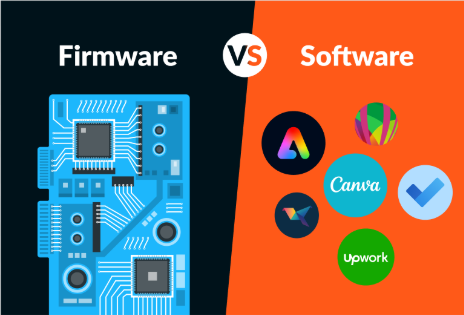
Firmware vs Software – What’s the Difference?
From smartphones to smart TVs, every device we use runs on some kind of software. But have you ever wondered about the term firmware and how it’s different from regular software?
Let’s break it down simply: firmware is a special kind of software that works behind the scenes — quietly powering your devices from deep within.
In this blog, we’ll explore:
- What firmware is
- How it differs from software
- Real-life examples
- Why both are important in tech
What is Firmware?
Firmware is a type of specialized software permanently stored in a device’s read-only memory (ROM). It controls the basic functions of hardware, such as booting a system or managing device communication.
Key Traits:
- Low-level software
- Stored in ROM or flash memory
- Not meant for regular user interaction
- Sometimes updatable (e.g., BIOS update)
Examples of Firmware:
- BIOS in computers
- Router firmware that controls connectivity
- Smart TV firmware managing display and remote input
- Embedded systems in washing machines, microwaves, etc.
Also read: What is Firmware? – The Hidden Software in Your Devices
What is Software?
Software is a broad term that includes all programs and operating systems that run on computers or devices. It can be system software, application software, utility software, and more.
Key Traits:
- Stored on hard drives or SSDs
- User-friendly and frequently updated
- Divided into system and application software
Examples of Software:
- Operating Systems (Windows, macOS, Linux)
- Web Browsers (Chrome, Firefox)
- Apps (Microsoft Word, VLC Player)
- Antivirus Programs, Photo Editors, etc.
Read: Types of Software Explained Simply
Firmware vs Software: Head-to-Head Comparison
| Feature | Firmware | Software |
| Location | Stored in ROM or flash memory | Stored on hard drive or SSD |
| Purpose | Controls hardware functions | Performs tasks and user functions |
| Modifiability | Limited updates (often by manufacturers) | Easily updated or reinstalled by users |
| User Interaction | Rare | Frequent |
| Examples | BIOS, router firmware, embedded systems | OS, games, browsers, apps |
How Firmware and Software Work Together
Imagine your firmware as the bridge that lets your hardware communicate with your software.
For example:
When you press the power button on your laptop, the firmware (BIOS) kicks in, checks if everything is working, and then loads the operating system (software) from the hard drive.
This collaboration makes modern computing possible.
Can Firmware Be Updated?
Yes! While firmware used to be “set in stone,” modern devices often allow firmware updates to fix bugs or add features.
Examples:
- Updating router firmware to improve Wi-Fi speed or security
- BIOS updates to support new hardware
- Smart TV updates for streaming services
Caution: Improper firmware updates can cause device malfunction. Always follow official guidelines.
Final Thoughts
Firmware and software may seem similar, but they serve very different purposes. Firmware lives closer to the hardware, ensuring it works smoothly, while software gives us the user-friendly features we interact with daily.
Understanding the difference helps you troubleshoot devices better, perform safe updates, and appreciate the hidden tech that powers your digital life.


